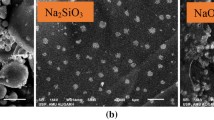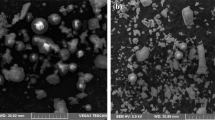Abstract
In this article Fly ash, GGBS and Metakaolin incorporated geopolymer concrete are investigated concerning the mechanical and durability characteristics of Geopolymer concrete. Conventional ordinary cement concrete is also cast to compare the results of this ternary blended geopolymer concrete. This particular concrete is produced using industrial by-products like fly ash, GGBS, and metakaolin which have Alumina and silica as major chemical compositions and can be called a sustainable building material as it utilizes industrial by-products. The main scope of this investigation is to produce eco-friendly geopolymer concrete through the utilization of waste materials, thereby addressing environmental concerns and promoting sustainable concrete production. Crimped Steel fibers with an aspect ratio of 66 were used in this investigation. The effect of varying compositions of GGBS, Metakoalin, and volume fraction of fibers on the strength and durability characteristics of ternary blends is studied. The durability of concrete is defined as the resistance of concrete under aggressive environmental conditions such as rain, wind and adverse climatic conditions without undergoing deterioration of concrete. Mechanical characteristics like compressive, flexural, and split tensile strength and durability characteristics like acid attack, sulphate attack, and chloride ion penetration are studied. The test results reveal that TGPC3-4 Mix showed superior mechanical characteristics and performed well in the durability test. When comparing these test results with those of conventional cement concrete, Ternary blended geopolymer concrete shows better results than OPC Cement concrete.
























Similar content being viewed by others
References
Al Bakri AM, Kamarudin H, Bnhussain M, Nizar IK, Rafza AR, Zarina Y (2012) The processing, characterization, and properties of fly ash based geopolymer concrete. Rev Adv Mater Sci 30(1):90–97
Albitar M, Mohamed Ali M, Visintin P, Drechsler M (2017) Durability evaluation of geopolymer and conventional concretes. Constr Build Mater 136:374–385. https://doi.org/10.1016/j.conbuildmat.2017.01.056
Al-Swaidani A, Soud A, Hammami A (2017) Improvement of the early-age compressive strength, water permeability, and sulfuric acid resistance of scoria-based mortars/concrete using limestone filler. Adv Mater Sci Eng 2017:1–17
Amran YM, Alyousef R, Alabduljabbar H, El-Zeadani M (2020) Clean production and properties of geopolymer concrete: a review. J Clean Prod 251:119679
Amran M, Al-Fakih A, Chu S, Fediuk R, Haruna S, Azevedo A, Vatin N (2021) Long-term durability properties of geopolymer concrete: an in-depth review. Case Stud Constr Mater 15:e00661. https://doi.org/10.1016/j.cscm.2021.e00661
ASTM C 1202-05 (xxxx) Standard test method for electrical indication of concrete ability to resist chloride ion penetration
Bakharav T (2005) Resistance of geopolymer materials to acid attack. Cement Concr Res 35:658–670. https://doi.org/10.1016/j.cemconres.2004.06.005
Balaguru PN, Shah SP (1992) Fibre reinforced cement composites. McGraw-Hill, New York
BIS 383: 1970 (1970) Coarse and fine aggregate from natural sources of concrete 9th Revision, BIS, New Delhi
Buyuktapu M, Murat Maras M (2023) Optimization of production parameters of novel hybrid fiber-reinforced geopolymer mortar: application in masonry walls. Structures 53:1300–1317. https://doi.org/10.1016/j.istruc.2023.05.031
Carriço A, Bogas JA, Hawreen A, Guedes M (2018) Durability of multi-walled carbon nanotube reinforced concrete. Constr Build Mater 164:121–133
Ganesan N, Abraham R, Deepa SR (2015) Durability characteristics of steel fibre reinforced geopolymer concrete. Constr Build Mater 93:471476
Hassan A, Arif M, Shariq M (2019) Effect of curing condition on the mechanical properties of fly ash-based geopolymer concrete. SN Appl Sci 1:2019
Hassan A, Arif M, Shariq M (2019a) Use of geopolymer concrete for a cleaner and sustainable environment: a review of mechanical properties and microstructure. J Clean Prod 223(2019):704–728. https://doi.org/10.1016/j.jclepro.2019.03.051
Hassan A, Arif M, Shariq M (2020a) A review of properties and behavior of reinforced geopolymer concrete structural elements: a clean technology option for sustainable development. J Clean Prod 245(2020):118762. https://doi.org/10.1016/j.jclepro.2019.118762
Hassan A, Arif M, Shariq M (2020) Mechanical behavior and microstructural investigation of geopolymer concrete after exposure to elevated temperatures. Arab J Sci Eng 5:6. https://doi.org/10.1007/s13369-019-04269-9
Hassan A, Arif M, Shariq M (2019) Development of low carbon binder for sustainable construction as an alternative to conventional concrete. In: National conference on ‘advances in structural technologies (CoAST-2019)’ organized by Department of Civil Engineering, NIT Silchar, February 01–03, 2019, pp 813–823
Hm T, Unnikrishnan S (2022) Utilization of industrial and agricultural waste materials for the development of geopolymer concrete-a review. Mater Today Proc 65:1290–1297. https://doi.org/10.1016/j.matpr.2022.04.192
Hm T, Unnikrishnan S (2023) Mechanical strength and microstructure of GGBS-SCBA based geopolymer concrete. J Mater Res Technol 24:7816–7831. https://doi.org/10.1016/j.jmrt.2023.05.051
IS 2185 (Part 1):2005 (2005) Concrete Masonry units—specification; Bureau of Indian Standards: New Delhi, India
IS 516:1959 (2004) Method of test for strength of concrete; Bureau of Indian Standards: New Delhi, India
IS 5816:1999 (2004) Splitting tensile strength of concrete-method of test; Bureau of Indian Standards: New Delhi, India
IS: 10262 standard code of practice for recommended guidelines for concrete mix design. New Delhi: BIS
Kamath M, Prashant S, Kumar M (2021) Micro-characterization of alkali-activated paste with fly ash-GGBS-metakaolin binder system with ambient setting characteristics. Constr Build Mater 277:122323. https://doi.org/10.1016/j.conbuildmat.2021.122323
Khale D, Chaudhary R (2007) Mechanism of geopolymerization and factors influencing its development: a review. J Mater Sci 42(3):729–746
Khalid S, Reshma TV, Shobha MS, Priyanka G, Satyanarayana Siriki V (2021) Analysis of strength and durability properties of ternary blended geopolymer concrete. Mater Today Proc. https://doi.org/10.1016/j.matpr.2021.08.307
Khalid SM, Shanthaveerappa SM, Vishweshwaraiah RT et al (2023) Potential utilization of industrial effluents in ternary blended geopolymer concrete for future sustainable environment. Innov Infrastruct Solut 8:104. https://doi.org/10.1007/s41062-023-01072-2
Kotop MA, Alharbi YR, Abadel AA, Binyahya AS (2021) Engineering properties of geopolymer concrete incorporating hybrid nano-materials. Ain Shams Eng. J. 5:1–7
Kumar VS, Ganesan N, Indira PV (2017) Effect of molarity of sodium hydroxide and curing method on the compressive strength of ternary blend geopolymer concrete. IOP Conf Ser Earth Environ Sci 80:012011
Kumar VS, Ganesan N, Indira P (2021) Engineering properties of hybrid fibre reinforced ternary blend geopolymer concrete. J Compos Sci 5:203
Kuun Reddy SR, Bala Murugan S (2020) Experimental and microstructural assessment of ternary blended geopolymer concrete with different Na2SiO3-to-NaOH volume ratios. Innov Infrastruct Solut 5:33. https://doi.org/10.1007/s41062-020-0279-z
Maras MM (2021) Characterization of performable geopolymer mortars for use as repair material. Struct Concr 22(5):3173–3188. https://doi.org/10.1002/suco.202100355
Maraş MM (2021) Mechanical and fracture behavior of geopolymer composites reinforced with fibers by using nano-TiO2. J Braz Soc Mech Sci Eng 43:412
Md Khalid S, Shobha MS, Tanu HM, Reshma TV (2021) Ternary blended geo-polymer concrete—a review. In: IOP Conference series: earth and environmental science, vol 822. https://doi.org/10.1088/1755-1315/822/1/012043.
Mehrzad MY, Ahmet B (2017) Stress-strain behaviour of geopolymer under uniaxial compression. Comput Concrete 20(4):381–389
Mehsas B, Siline M, Zeghichi L (2022) The effect of using low reactive metakaolin on performances of geopolymer binder. Innov Infrastruct Solut 7:233. https://doi.org/10.1007/s41062-022-00833-9
Nagajothi S (2022) Durability studies on fly ash based geopolymer concrete incorporated with slag and alkali solutions. Adv Civ Eng 7:13. https://doi.org/10.1155/2022/7196446
Neville AM (1995) Properties of concrete, 4th edn. Wiley, London
Rangan BV (2006) Studies on low calcium fly ash based geopolymer concrete. Indian Concr J 5:9–17
Rashad AM (2014) A comprehensive overview of the influence of different admixtures and additives on the properties of alkali-activated fly ash. Mater Des 53:1005–1025
Sathia R, Ganesh B, Manu S (2008) Durability study of low calcium fly ash geopolymer concrete. In: The 3rd ACF international conference, pp 1153– 1159
Sathish KV, Ganesan N, Indira PV (2021) Effect of hybrid fibres on the durability characteristics of ternary blend geopolymer concrete. J Compos Sci 5:279
Seyed HGM (2021) Strength and chloride ion penetration resistance of ultra-high-performance fiber-reinforced geopolymer concrete. Science. https://doi.org/10.1016/j.istruc.2021.03.112
Sharmin A, Alengaram UJ, Jumaat MZ, Yusuf MO, Kabir SA, Bashar II (2017) Influence of source materials and the role of oxide composition on the performance of ternary blended sustainable geopolymer mortar. Constr Build Mater 144:608–623. https://doi.org/10.1016/j.conbuildmat.2017.03.178
Singh NB (2018) Fly ash based geopolymer binder: a future construction material. Minerals 8:299
Singh B, Ishwarya G, Gupta M, Bhattacharyya SK (2015) Geopolymer concrete: a review of some recent developments. Constr Build Mater 85:78–90
Tahir MFM, Abdullah MMAB, Rahim SZA, Mohd HMR, Sandu AV, Vizureanu P, Ghazali CMR, Kadir AA (2022) Mechanical and durability analysis of fly ash based geopolymer with various compositions for rigid pavement applications. Materials 15:3458
Tanu H, Unnikrishnan S (2023) Review on durability of geopolymer concrete developed with industrial and agricultural by products. Mater Today Proc. https://doi.org/10.1016/j.matpr.2023.03.335
Yadollahi MM, Benli A, Demirboğa R (2015) The effects of silica modulus and aging on compressive strength of pumice-based geopolymer composites. Constr Build Mater 94:767–774. https://doi.org/10.1016/j.conbuildmat.2015.07.052
Yin K, Ahamed A, Lisak G (2018) Environmental perspectives of recycling various combustion ashes in cement production-a review. Waste Manage 78:401–416
Author information
Authors and Affiliations
Corresponding author
Ethics declarations
Conflict of interest
The authors affirm that they do not have any known conflicting financial interest or personal relationships that could have potentially influenced the findings presented in this paper.
Rights and permissions
Springer Nature or its licensor (e.g. a society or other partner) holds exclusive rights to this article under a publishing agreement with the author(s) or other rightsholder(s); author self-archiving of the accepted manuscript version of this article is solely governed by the terms of such publishing agreement and applicable law.
About this article
Cite this article
Khalid, S.M., Shobha, M.S. Effect of Ternary Blends on Mechanical Strength, Durability and Microstructural Properties of Geopolymer Concrete. Iran J Sci Technol Trans Civ Eng (2023). https://doi.org/10.1007/s40996-023-01241-4
Received:
Accepted:
Published:
DOI: https://doi.org/10.1007/s40996-023-01241-4




